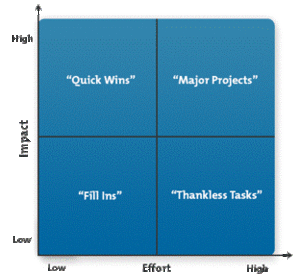Action Priority Matrix (APM)
What is Action Priority Matrix (APM)?
An Action Priority Matrix makes it easier to make decisions and sets out clearly which activities must be finished on time and which activities can be omitted or performed at a later time. An Action Priority Matrix is a simple diagramming technique that helps you choose which activities to prioritize in order to make the most efficient use of your time. In an Action Priority Matrix the Efforts of the activity (x-axis) are plotted perpendicularly on the Impact/ detailing (y-axis).[1]

source: Mindtools
To use the matrix, you score tasks based firstly on their impact and secondly on the effort needed to complete them. You then use your scores to plot these activities in one of four quadrants:
- Quick Wins (High Impact, Low Effort): Quick wins are the most attractive projects because they give you a good return for relatively little effort. Focus on these as much as you can.
- Major Projects (High Impact, High Effort): Major projects give good returns, but they are time-consuming. This means that one major project can "crowd out" many quick wins.
- Fill Ins (Low Impact, Low Effort): Don't worry too much about doing these activities – if you have spare time, do them, but drop them or delegate them if something better comes along.
- Thankless Tasks (Low Impact, High Effort): Try to avoid these activities. Not only do they give little return, they also soak up time that you should be using on quick wins.[2]
Using the Action Priority Matrix[3]
This matrix looks a lot like the Eisenhower Matrix and also serves as a decision-making tool. But instead of being scored by their importance and urgency, activities are scored by their effort and impact in the Action Priority Matrix.
- Step 1: Make a list of all your activities.
- Step 2: Score the activities based on their impact and the effort you have to put into them to complete them. You can use a school grading scale from A (= high) to F (= low) or a 1-10 scale, or any other scale to score the activities according to their impact and effort needed to complete them.
- Step 3: Plot the activities on your Action Priority Matrix based on their scores.
- Step 4: Prioritize your activities:
- Quick Wins get the highest priority.
- Focus the remaining time on Major Projects.
- If you have capacities left, do the Fill In activities. If not, delegate these tasks.
- Eliminate Thankless Tasks.
The Action Priority Matrix is a simple visual tool that prioritizes a group of ideas, solutions, or actions across two dimensions: effort and impact. Effort represents any number of factors such as cost, time, resources, organizational obstacles, legal hurdles, etc., that are required to bring your idea or solution to fruition. Impact represents the desired aggregate effect of implementing an idea or solution. Impact can be quantitative in nature (e.g., sales, costs, profitability) or qualitative (e.g., workforce morale, customer perception). The Action Priority Matrix is not designed to provide an exact answer on which idea or solution to pursue; its purpose is to help the team (or an individual) move forward in the decision-making process by segregating and prioritizing a large set of heterogeneous ideas or solutions into a visual matrix that is based on the team’s expertise and experience. The Action Priority Matrix is not a substitute for in-depth quantitative analysis, but rather should be used early in the process to strain the ideas and solutions with highest ratio of impact to effort.[4]
See Also
References
Further Reading
- Time Management - The Action Priority Matrix Source Point
- Action Priority Matrix Template Toolshero
